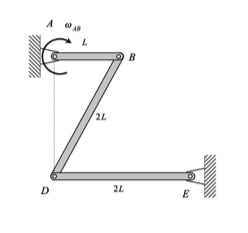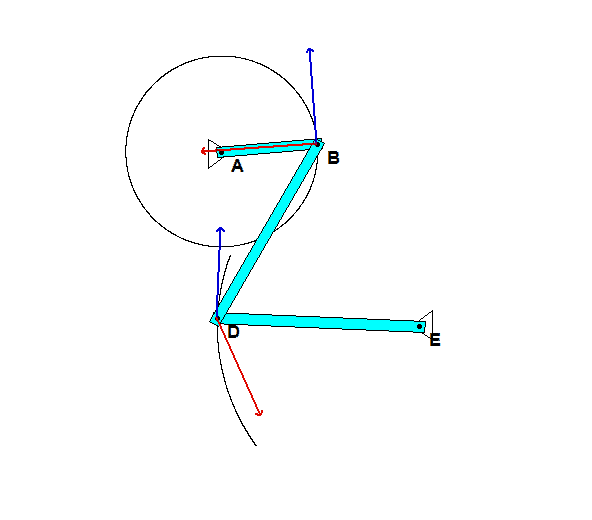| Problem statement Solution video |
DISCUSSION THREAD
For this problem, please use a CLOCKWISE rotation for link AB (that is, use what the problem figure indicates).

Discussion

The motion of this four-bar mechanism is quite complicated. However, we can make some sense out of the velocities of points B and D by using instant centers (ICs). For a given position of the mechanism, can you visualize the location of the IC for link BD? And from this location, do the directions for the velocities for points B and D make sense?
HINTS:
You are asked to perform the complete kinematical analysis for the mechanism for the position shown below.
Velocity
For the velocity analysis, you are encouraged to use the IC center approach. Where is the IC for link BD located? What does the location of this IC say about the angular velocity of link BD? Use that result to determine the angular velocity of link DE.
Acceleration
This is a standard kinematics of a mechanism problem. For this, consider the following steps:
- Write down the acceleration of point B using link AB.
- Write down the acceleration expression for D using link DE.
- Write down the acceleration expression for B using link DB and your result for the acceleration of D from Step 2.
- Equate the expressions for the acceleration of B in Steps 1 and 3 above. From this, solve for the angular accelerations of links BD and DE.

Any questions?? Please ask/answer questions regarding this homework problem through the "Leave a Comment" link above.
The problem statement says the angular speed of AB rotates it counter-clockwise about A, but the diagram included clearly shows it as clockwise. Which should we use for the problem?
I would use counter clockwise, that is what the animation has as well.
Sorry for the typo. The text should read as the figure is drawn - AB is rotating CLOCKWISE. The solution from which the grading is to be done has used CW.
Make sure to identify your perpendicular lines and then analyze what kind of system you are working with. When solving for w_bd make sure to equate the cross product of the accompanying velocities.
In terms of what should our answer be in? Would it be wA since that is what we are given?
never mind thought we had to solve for regular velocity.
What should the angular acceleration and angular velocity be in terms of?
They have to be in terms of omega AB and if needed L since the only thing that we know for sure is that omega AB is given.
Would the velocities of B and D be equivalent because BD experiences translational motion?
Yes. The IC for BD is at infinity, which tells us that the angular velocity of BD is zero. If the angular velocity of a rigid body is zero, then all points on the body have the same velocity.
Shouldn't it be that all points on the body have the same velocity, not no velocity?
Oops…typing too fast and I did not proofread. Thanks for the correction.
With radial B and radial D lines not intersecting after drawing perpendicular lines of points B and D, we can say angular velocity of BD is zero, which means angular acceleration of BD is also zero. That should help eliminate parts of equations needed in part (b).
I would recommend after solving for Omega_DE to set up a system of equations, those being:
1. acceleration of B equation based on point A
2. acceleration of D equation based on point B
3. acceleration of D equation based on point D
These are 3 rigid body equations that you should be able to use in conjunction. This should be enough information to solve for the angular accelerations.
^^
In my defense, I did not read the hints before making this comment, even though it looks very similar.
I am a bit confused. We decided that v_b = v_d since they are a rigid body with no angular velocity, it should be true that a_b = a_d right? But the picture shows that a_b and a_d do not equal each other because a_d has a j component while a_b does not.
For part b, to find both alpha_de and alpha_bd, you need to have 3 equations cause when you do a_bd, you gonna need to know what a_b is. One way to find a_b is through a_ab because angular acceleration will be 0 (angular velocity is constant) . Hope that helps!
It is helpful to draw a good free body diagram, and draw out/ note what you believe the values you are finding should be based on common sense. Then, when you solve you can check with what you assumed and see if they match. If not, it can help show where you messed up for longer problems like this one.
I found that part A of this problem was very similar to homework 2H based on the system's diagram setup, and the relationships found between the velocities